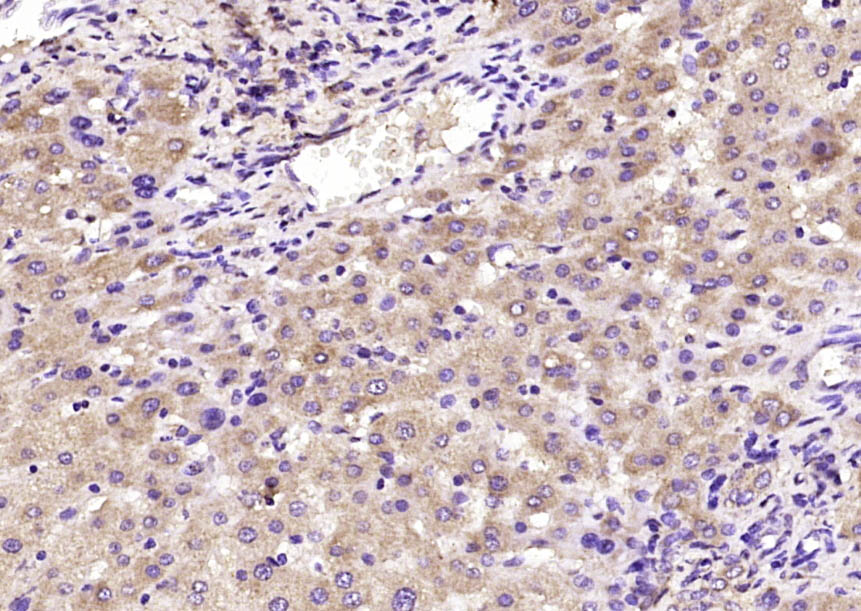
Rabbit Anti-Ceruloplasmin antibody
CER; caeruloplasmin; Ceruloplasmin precursor; CP 2; CP; CP2; CP-2; EC 1.16.3.1; Ferroxidase; CERU_HUMAN.
View History [Clear]
Details
Product Name Ceruloplasmin Chinese Name 铜蓝蛋白抗体 Alias CER; caeruloplasmin; Ceruloplasmin precursor; CP 2; CP; CP2; CP-2; EC 1.16.3.1; Ferroxidase; CERU_HUMAN. Research Area Tumour Cardiovascular Cell biology immunology Immunogen Species Rabbit Clonality Polyclonal React Species Human, Rat, (predicted: Mouse, Dog, Rabbit, ) Applications ELISA=1:5000-10000 IHC-P=1:100-500 IHC-F=1:100-500 IF=1:100-500 (Paraffin sections need antigen repair)
not yet tested in other applications.
optimal dilutions/concentrations should be determined by the end user.Theoretical molecular weight 120kDa Cellular localization Secretory protein Form Liquid Concentration 1mg/ml immunogen KLH conjugated synthetic peptide derived from human Ceruloplasmin: 551-650/1065 Lsotype IgG Purification affinity purified by Protein A Buffer Solution 0.01M TBS(pH7.4) with 1% BSA, 0.03% Proclin300 and 50% Glycerol. Storage Shipped at 4℃. Store at -20 °C for one year. Avoid repeated freeze/thaw cycles. Attention This product as supplied is intended for research use only, not for use in human, therapeutic or diagnostic applications. PubMed PubMed Product Detail Caeruloplasmin is a copper binding plasma glycoprotein consisting of a single polypeptide chain. It has a molecular weight of 132kDa and occurs in plasma at a concentration of 150-500 mg/L. Although the physiological functions of Caeruloplasmin are not fully understood it is implicated in a number of possible functions. 95% of plasma copper is bound to Caeruloplasmin, implying some involvement in copper transport. Caeruloplasmin has been described as both an oxidant and an antioxidant, its exact role or roles in this respect are not clear. Plasma levels of Caeruloplasmin are elevated after inflammation and trauma and it is therefore classified as an acute phase protein. The measurement of Caeruloplasmin in plasma is useful in the diagnosis of Wilson’s disease, where levels are greatly reduced. Caeruloplasmin is extremely labile in plasma and rapidly degrades to 115kDa and 19kDa fragments. The age of plasma samples should therefore be taken into account when interpreting immunological analysis of caeruloplasmin.
Function:
Ceruloplasmin is a blue, copper-binding (6-7 atoms per molecule) glycoprotein. It has ferroxidase activity oxidizing Fe(2+) to Fe(3+) without releasing radical oxygen species. It is involved in iron transport across the cell membrane. Provides Cu(2+) ions for the ascorbate-mediated deaminase degradation of the heparan sulfate chains of GPC1. May also play a role in fetal lung development or pulmonary antioxidant defense.
Subcellular Location:
Secreted. Note=Colocalizes with GCP1 in secretory intracellular compartments.
Tissue Specificity:
Expressed by the liver and secreted in plasma.
DISEASE:
Aceruloplasminemia (ACERULOP) [MIM:604290]: An autosomal recessive disorder of iron metabolism characterized by iron accumulation in the brain as well as visceral organs. Clinical features consist of the triad of retinal degeneration, diabetes mellitus and neurological disturbances. Note=The disease is caused by mutations affecting the gene represented in this entry.
Note=Ceruloplasmin levels are decreased in Wilson disease, in which copper cannot be incorporated into ceruloplasmin in liver because of defects in the copper-transporting ATPase 2.
Similarity:
Belongs to the multicopper oxidase family.
Contains 3 F5/8 type A domains.
Contains 6 plastocyanin-like domains.
SWISS:
P00450
Gene ID:
1356
Database links:Entrez Gene: 1356 Human
Entrez Gene: 12870 Mouse
Omim: 117700 Human
SwissProt: P00450 Human
SwissProt: Q61147 Mouse
Unigene: 558314 Human
Unigene: 13787 Mouse
铜蓝蛋白(ceruloplasmin,CER)又称铜氧化酶,是一种含铜的α2glycoprotein,CER具有氧化酶的活性,起着抗氧化剂的作用。在血循环中CER的抗氧化活力可以防止组织中脂质过氧化物和自由基的生成,特别在炎症时具有重要意义,也属于一种急性时相反应蛋白。
铜蓝蛋白对多酚及多胺类底物有催化其氧化之能力铜蓝蛋白具有遗传上的基因多形性。其作用为调节铜在机体各个部位的分布、合成含铜的酶蛋白.一般认为铜蓝蛋白由肝脏合成,一部分由胆道排泄,尿中含量甚微。铜蓝蛋白测定对某些肝、胆、肾等疾病的诊断有一定意义。Product Picture
References (0)
No References
Bought notes(bought amounts latest0)
No one bought this product
User Comment(Total0User Comment Num)
- No comment



 +86 571 56623320
+86 571 56623320
 +86 18668110335
+86 18668110335

